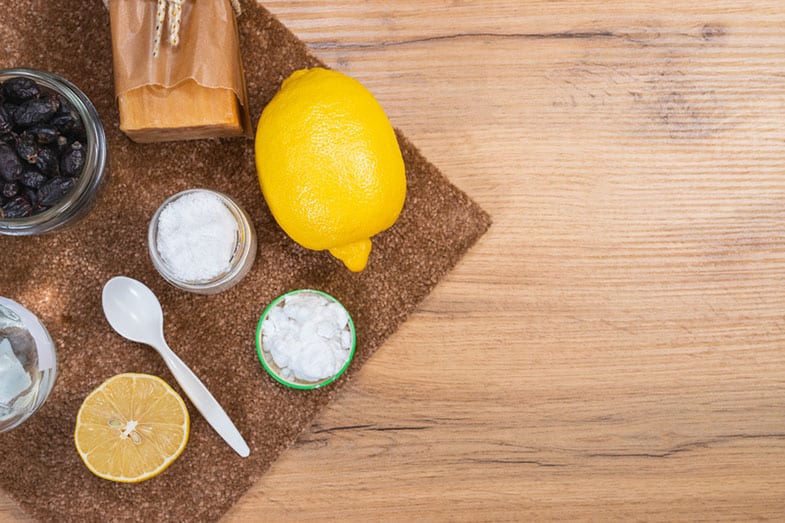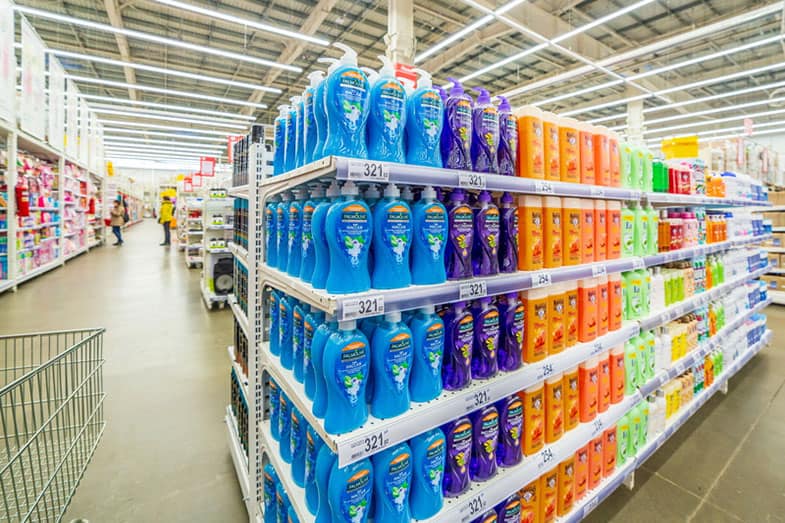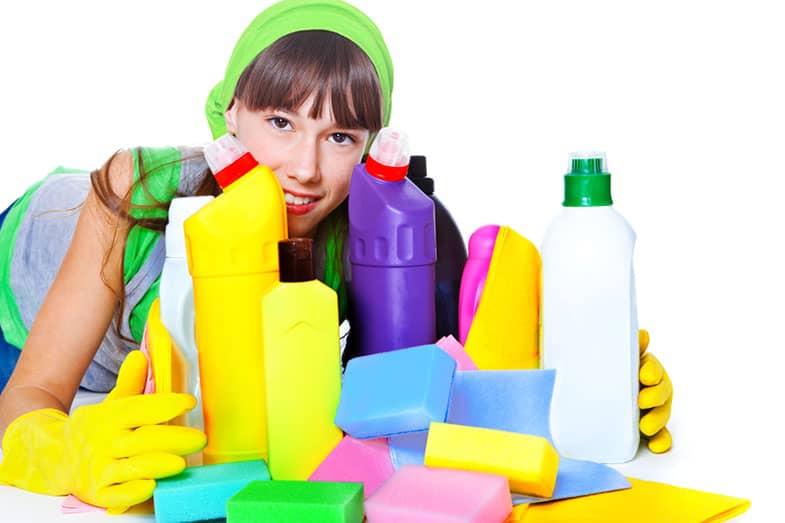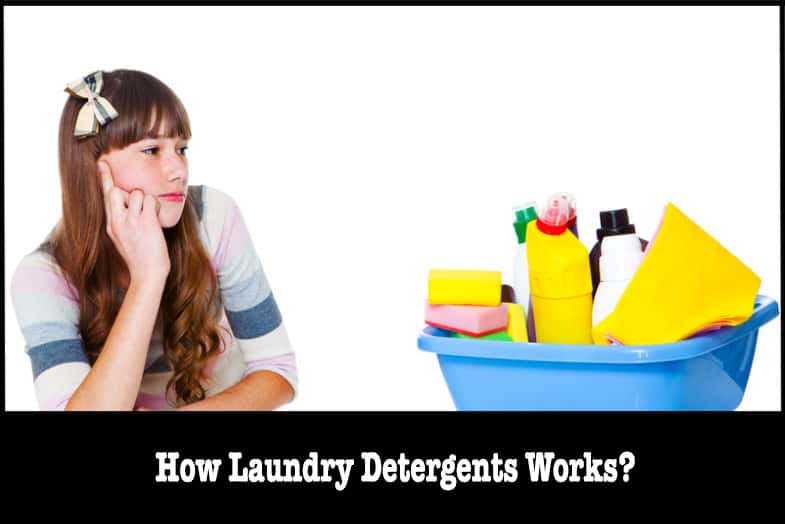Detergents were introduced in response to the shortage of animal and vegetable fats used to make soap during the Great World War.
The invention of laundry detergents was introduced in the early 20th century by Otto Rohm. He named his detergent Burnus, and by 1920, it was the most widely distributed laundry detergent in Germany.
Before this invention, garments were typically beaten over rocks, scrubbed with abrasive sand or stone, and pounded underfoot or with wooden implements in the uncivilized era.
Composition
Detergents are used for cleaning purposes because pure water alone does not have the tendency to remove oily and organic soiling. They allow grease and water to mix so that the dirt can be removed during laundry.
The detergents we use are primarily surfactants (chemicals that reduce the surface tension of the liquids they dissolve in) and phosphates. They can be derived easily from petrochemicals. It reduces the surface tension between the molecules of water to interact more with oil and grease than itself.
They are more than just surfactants. They contain enzymes to degrade protein-based stains, bleaches to de-color stains and add power to the cleaning agents, and blue dyes to counter yellow stains on clothes.
Read More: What Are These Blue Stains on My Washed Clothes?
Preparation

Although many people refer to laundry detergents as “soap.” But it is actually a combination that functions much like soap. The advantage of using detergents is that they can be derived from crude oil, unlike the hydrocarbons used in soaps that generally come from plants and animals.
Preparation of detergents involves the use of soaps. They can even be prepared at home, which is relatively easy and effective. The bar of soap is grated into a fine powder in the first step. A blender can be used for this process.
A small amount of water is added to the soap powder, just enough to make it wet. Then it is boiled until it is converted into a slick chunk. This slick glob is then blended with some other ingredients, which are given below:
- Washing Soda
- Baking Soda
- Borax
Stir all these ingredients until they are well mixed. Add the amount of water required in the bucket. Essential oils can also be used for better efficiency and scent. Leave it overnight before using it. If essential oils are to be used, add them once the mixture is cooled.
There are other industrial processes for the formation of detergents. Some important preparation methods are:
- The blender process.
- The agglomeration process.
- The slurry method
All these processes create dry detergents. Suppose the detergent is to be liquid rather than powder. In that case, all the ingredients are blended with a solution consisting of water and solubilizers (help the water and detergent to diffuse to the maximum extent).
Read More: Detergents and Soap: What’s the Difference?
Mechanism
The important process behind doing the laundry is not the drive belt of a washing machine or the electric motor that rotates the clothes all around the machine. The sole process behind it is the use of detergent.
Water alone cannot clean clothes because it won’t attach to molecules of grease and dirt. Water has an adhesion property due to which its molecules tend to attach with itself rather than combine with the dirt on the clothes.
The detergents contain surfactants, which are made of molecules that have two different ends. One end is strongly hydrophilic, so it combines with water, while the other end is hydrophobic. It repels water and adheres to grease and dirt more efficiently. The wash cycle of the laundry detergents occurs in the following steps:
- During the wash cycle, when the detergents are added to the water, the surfactants mix with water rapidly.
- As we discussed, the hydrophobic (which mixes up with grease and dirt) ends of the surfactant molecules start to attach themselves to the dirt and oil on your laundry. The spinning motion of the washing machine comes into play here. The tumbling motion rotates the jeans rapidly, which helps break the grease and the dust particles into simpler, smaller, and easy-to-remove pieces.
- During this cycle phase, the surfactant molecule’s water-loving (hydrophilic) ends attach themselves to the water molecules. Now, both sides of the surfactant molecules are attached—one end to the dirt and grease and the other to the water.
- The spinning motion of the machine helps the water molecules pull the surfactants attached to dirt and grease away from the clothes. The dirty water flushes away from the machine during the final spin, which leaves your laundry clean and tidy.
The other factor that comes into play while doing laundry is the temperature. In addition to the chemical effect of the detergent and the physical rotation of the washing machine, the temperature of the water plays a significant role.
The cleaning action has its physics involved. You need a certain amount of energy to remove the dirt. This energy will be available in the form of chemical, mechanical, and part thermal energy. You can reduce any one of these by increasing the other type of energy.
So, for example, if you use fewer amounts of detergents, the chemical energy will be decreased, but by increasing the temperature of the water in the machine, thermal energy will provide the necessary energy to remove the dust. Or you can wash the laundry for a longer period of time so that the mechanical energy will be increased, but it will consume more time.
Detergents accomplish nothing except attachment to the soil until some mechanical energy is added to the equation. Swishing the water around allows the detergent to pull the grease or dirt away from clothes and into the larger pool of rinse water. Rinsing washes the detergent and dirt away from the clothes.
Hot water melts grease and oils so that it is easier for the detergents to dissolve the grease or oil and pull it away into the rinsing water. Detergents are similar to soap, but they are less likely to form films and are easily applicable in hard water, too.
Modern Detergents

Modern detergents use advanced ingredients for the maximum efficiency of the detergent. They can be derived from petrochemicals or oleochemicals obtained from plants and animals. Chemicals like alkalis and oxidizing agents are also present in it. The functions of these chemicals are given below:
Oxidizers
Hydrophilic components of the surfactants can be produced with the help of molecules like ethylene oxide, sulfuric acid, and sulfur trioxide. They are highly reactive compounds. They can also act as bleaches. They also provide the energy source for chemical reactions.
Alkalis
These components are common in both soaps and detergents. Potassium hydroxide and Sodium are used in detergents. They also promote chemical reactions by providing positively charged ions.
Petrochemicals/Oleochemicals
They are hydrocarbon chains of fats and oils that are attracted to the oily and greasy dirt, which then attach with the surfactants and then rinsed out with water.
Chemical Mechanism
Detergents are amphipathic molecules. They contain hydrophilic or polar heads at the end of the long lipophilic tails. Their property to decrease the surface tension of water makes them surfactants.
These characteristics allow the detergents to propagate in the aqueous medium. In most detergents, the composition of the weight is made up of chemicals known as water conditioners.
The water we use daily is full of things like calcium and other hard metals that interfere with the laundry process, so these water conditioners attract and attach them, keeping them out of the way.
This is why in places where hard water (which contains lots of these metals) is available, you have to use more laundry detergent because the more the metals there are in the water, the greater amount of water conditioners are required to hold them and inhibit them from interfering with the washing process.
Water Conditioner
The water conditioner commonly used is a chemical called sodium carbonate, which helps to hold the metals and grab them tight. Back in the day, laundry detergents used sodium triphosphate, which was more efficient, but it caused problems by encouraging the growth of algae and harmful organisms like it in rivers, killing other wildlife, and destroying native plants and fish ( eutrophication).
So, the use of sodium triphosphate was inhibited and replaced by the less effective (but bio-friendly) sodium carbonate. These water conditioners constitute more than half of the contents of the detergent by weight.
Surfactants

Surfactants form almost half the composition of the detergents and have the second largest composition by weight in detergents, which is one of the main active ingredients that lifts and removes stains. These surfactants have a complex nature.
Many detergents nowadays are a class of chemicals called alkylbenzene sulfonates, which are made of long chains of a chemical known as dodecane, composed of long chains of Carbon and Hydrogen, also known as hydrocarbons.
This chemical readily forms long-chain molecules, quite related to petrochemicals like crude oil. A benzene ring is attached to it, with a sulfate molecule attached. These two parts are totally opposite in being hydrophilic and hydrophobic.
The dodecyl chain is hydrophobic, doing all it can to stay away from it. The benzo sulfate is hydrophilic and wants to get close to it. This disagreement is what makes detergents so efficient.
Dodecyl chains don’t react with water but interact with each other and also react with other chemicals like fats, sugars, proteins, and others. In other words, all of the dirt or grease on your clothes that you want to get off.
Read More: Anionic Surfactants: Best Cleansing and Foaming Products
Process
After putting a small amount of detergent in the laundry, these two parts of the detergent molecules react in their own way. The benzo sulfate, which is hydrophilic, is eager about loosely bonding with water, while the dodecane chain doesn’t interact with water.
If these molecules clash with something like dirt, they make a complex, with the dodecyl chain attached to the fat and the benzo sulfate chain attached to the water.
After some time, the bit of fat will attract the dodecyl chain of more detergent molecules, covering it gradually. The benzosulfate is still attached to water, though. As time passes, the two create a complex by creating a small globe around the bit of fat or oil, which then rinses off the shirt into the water.
In this complex state, the dodecyl chains are attached to the fat and the other neighboring dodecyl chains, and the benzo sulfate is attached to the water molecules present around it. And that’s how the stains are removed from your shirt: they are covered and freed by these enclosing globes of detergent.
These closed globes (called micelles) are very small, usually composed of just a few hundred molecules in each globe floating in the water.
According to chemists, this type of solution is called colloid because the dirt or grease isn’t readily diffused in the water; they are instead held in these microscopic micelles. To you, it looks like the stains are dissolved in the water, and when the water is drained, it takes the stains with it down the drain.
Composition
These surfactants constitute about 40 percent of the composition of the detergent by weight, and they are assisted by chemicals such as enzymes and others that remove stains and help the process run efficiently.
This is a detailed overview of the mechanism of the detergents.
Read More: 10 Laundry Detergent Types You Must Know
Conclusion
Laundry detergents are the best available option to wash your clothes. Unlike soaps, they even work in hard water. They also prevent soap remains and insoluble salts from attaching to your clothes.
These factors work on the surface of your clothes and break up the dirt into easily removable parts. This makes it easier to scrub them. Detergents are also helpful in extending the life of your clothes.
The presence of surfactants makes it more effective against all dirt and grease. Synthetic detergents are easily soluble in water. They are more eco-friendly and bio-degradable too.
Some detergents are toxic and dangerous for the environment, so it is necessary to choose the right detergent for your laundry work. They are derived from petroleum, so they save natural vegetable oils essential for nourishment needs.

